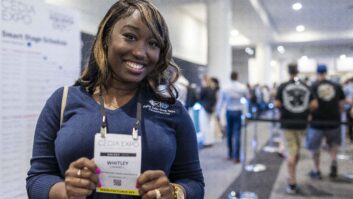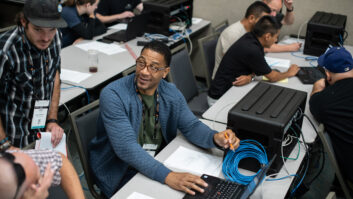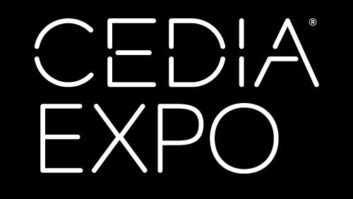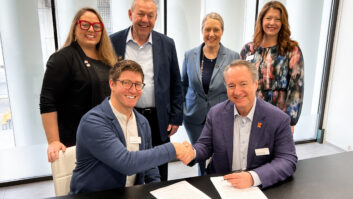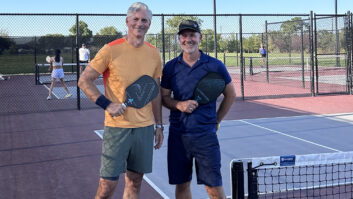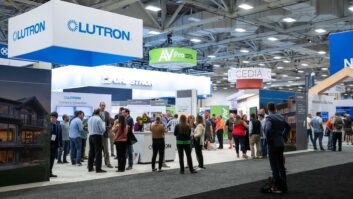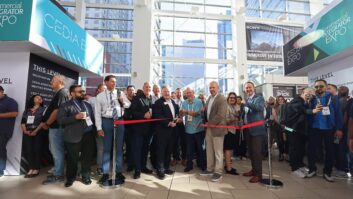You don’t hear manufacturers talking about the chummy relationships they have with their competitors in too many industries.
This revelation, casually mentioned at one of the booths I visited last week at CEDIA EXPO in Denver, epitomized the feeling of the show for me. Not only were moods much higher and booths much busier than the past few EXPOs, but everywhere I looked I caught old friends reconnecting and camaraderie even amongst competing brands. [Check out what blogger Heather Sidorowicz had to say about more brands working together at EXPO here.
The show was undoubtedly a big success on many levels. There was a noted increase in first-time exhibitors—the official CEDIA numbers were 109 first time exhibitors, up from 92 at EXPO 2012—and I couldn’t help but notice several exhibitors returning from hiatuses.
Hunter Douglas was one of these exhibitors that had not made an appearance with a booth on the show floor in several years. This EXPO was strategic for the window fashions and motorized shading manufacturer as those technologies, which Hunter Douglas has been in the business of since 1946, have become a prominent source of growth for custom installers. The show introduction of its Platinum Gateway and Repeater System, along with the Platinum App really catalyzed Hunter Douglas’ return to EXPO, David Parrett, director, dealer marketing programs and corporate marketing, told me.
The Platinum Gateway and Repeater System was designed to operate the entire spectrum of Hunter Douglas motorized products, controlled via the Platinum App and third-party systems via serial and IR communication. The Platinum App features a timer for users to schedule customized scenes for the Platinum Gateway to activate. The Platinum Repeaters work with the Gateway to extend signal range to cover the scope of large homes. Shades can be integrated with a security system as well. The app is designed to “give a lot of control to the consumer,” said Cliff Sparks, manager, training programs, customer education and development groups. Yet, Hunter Douglas remains “very protecting of the dealer,” Parrett said.

Hunter Douglas’ Platinum Gateway
Over at the Z-Wave Alliance’s booth, following a really unique display of its control capabilities by a hiker atop a Himalaya mountain, which I sadly missed, representatives touted the new 500 Series chip, heralding in the Z-Wave Next Gen product portfolio. The chip will enable products to be much faster and capable of more memory while bringing the price down. Products are currently in development with some scheduled to be out by the end of the year.

Søren Daugard (standing), interoperability lab manager for the Z-Wave Alliance, chats via satellite with Mariusz Malkowski (on screen), and amateur mountain climber and Sigma Designs engineer, who was scaling Mount Cho Oyu in Tibet. Malkowski successfully controlled a number electronic devices set up in the Z-Wave booth at CEDIA EXPO, over 7,000 miles away.
Bryston, known for its amps, was showings its first loudspeaker offerings. The eight-model line consists of the floorstanding Model T, Middle T, and mini t, as well as the T powered sub, two center channel solutions, and an in-wall and on-wall loudspeaker. James Tanner, VP sales and marketing, has led the design team, developing proprietary drivers, crossovers and enclosures, along with a rigorous test regimen. The A Series of speakers are similar with a smaller footprint. Architectural speaker model prototypes were well received at the show, so Bryston has determined to move forward with those models.
I went by the Thiel booth, where they showed a new product set for CES 2014 in January, followed by a stream of new products in 2014. More of note for Thiel at EXPO were several recent new hires: Mark Mason, director of product development; and Bob Brown, named earlier this year as interim COO and a boardmember. RS editor Jeremy Glowacki interviewed and wrote about Brown in February. Stephen DeFuria also joined Thiel earlier this year as national sales manager.
I made a quick stop at Salamander’s booth, a shared space with Leon Speakers, emphasizing the interior design-centric focus. Salamander’s AV furniture is all built to order custom, carrying a lifetime warranty. I was surprised to learn this includes theater seating, an always welcome “demo” on the show floor.
In other shared booth space, I visited Energy Squad, a new distributor of environmentally friendly technology, exhibiting alongside RoseWater Energy Group, a next-gen energy storage provider.
LED lighting is a huge part of Energy Squad’s story. The distributor—launched last year at CEDIA as the brainchild of Maryland integration firm Bethesda Systems—offers 35 different brands of lighting, mostly LEDs. Jonathan Stovall, founder and CEO, told me that Energy Squad has created 30-point margin lines for LEDs, as he noted how thin LED margins can be. He was eager to demonstrate the simplicity of DMF Lighting’s modular LED design.

Jonathan Stovall, founder and CEO of Energy Squad, demonstrated the simplicity of DMF Lighting’s modular LED design.
The next step for Energy Squad has been educating dealers about how they can sell LEDs, which is the most common question Stovall said his company has been fielding. As a result, Energy Squad launched the LED Diet, a sales tool for dealers to market and sell LED lighting. “This is a way for dealers to make money,” Stovall stated.
In brief, the LED Diet arms dealers (or LED dieticians) with a duffel bag of LED solutions with which to make free home assessments. The kit enables the “dieticians” to spec and sell all on site immediately, via a snazzy iPad app. Check out the full details here. Read Stovall’s recent story in RS sister publication SCN about selling LEDs here.
Energy Squad is marketing heavily to both dealers and consumers, appearing at local Bethesda, MD farmer’s markets to hit on the most energy conscious consumers.
Over on the RoseWater Energy Group side, I enjoyed a refreshing business chat with Joe Piccirilli, managing director, who was glowing with optimism over the state of energy efficiency technology and the interest there is for it in our industry. Piccirilli was one of the original founders of AVAD and has a long, storied resume in CE.
RoseWater offers the Residential Energy Storage Hub, a smaller version of which was introduced at CEDIA EXPO last week. The energy hub uses a range of battery solutions to accommodate the multitude of electronics occupying most homes today, along with their high-energy demands. The new Model 1012 is less than half the size of its predecessor. The unique battery is at the heart of this system. ESCs can specify and incorporate a customized, modular battery solution based on local climates, physical location of the hub, battery lifecycles, and the specific demands of a home’s connected systems. The hub also includes a backup generator and commercial controls and monitoring. The Residential Energy Storage Hub does much more than this though, so read more about the Model 1012 here.
Piccirilli told me that CEDIA EXPO was “an amazingly good show” for them this year. Energy-efficient products have really taken off at the EXPO, he said, noting how he used to be the only one talking about this type of technology, and now dealers are coming specifically to see RoseWater. “It’s good to be a pioneer” in the field, he said.
Piccirilli also made a rather bold prediction I personally hope comes true: “Within a decade, I really believe a product like this will be as common as a dishwasher.”
IMS Engineered Products, or Installer’s Choice, was another booth where I heard more about how successful the show was. Jim Walenda, director of marketing, said traffic at their booth tripled this year. Walenda highlighted the 12 different colors that IMS racks are available in, as well as the ability to do private branding for custom finishes. IMS racks are shipped completely assembled from its factory in suburban Chicago. Walenda and VP of sales and marketing Kevin Groom demonstrated the company’s online rack configurator, a really simple solution to streamline the process for dealers.
One company I was not familiar with at all before EXPO was Simplicikey, an electronic door lock manufacturer. There are some pretty big players in this field already, but Simplicikey distinguishes itself with its own proprietary control technology with low power consumption. This is the big differentiator between Simplicikey’s technology and Z-Wave certified locks, according to D’Vell M. Garrison, vice president, sales and marketing. “If it’s a low power device, than we can make it happen,” Garrison said, commenting on the ability to support 120 different devices, including fans, shades, lights, and locks. Eventually, Simplicikey will offer lighting products, but the concentration remains on locks for the moment, Garrison told me.

Simplicikey’s D’Vell Garrison, VP sales and marketing
The Simplicikey app will be available in November. The company has an open API for integration, but will probably work with drivers eventually, Garrison said. Simplicikey’s parent company is a defense contractor, so its role in the security market is backed up well.
Over at Leviton’s booth (formerly HAI), I learned how security is the basis for its control systems. In the lighting department Leviton offers interoperable devices that work with Z-Wave, ZigBee, and others. “We really want to be that universal system,” said Greg Rhoades, director of marketing, security and automation. “We want to work with everyone. If you’re truly interested in the connected home, you have to be open.”
Rhoades went on to tell me how Leviton integrates with many of its competitors, a concept dubbed “co-opetition,” seeing competition as a chance for partnership, he said.
Over at Yamaha, the “separates” category reappeared for the first time in 25 years, as customers have been requesting individual preamp and amp offerings. The CXA5000 11.2 channel preamp and the MX-A5000 11-channel power amp with 300W per channel. The preamp features dual high performance ESS Technology SABRE32 Ultra DACs, for accurate sound imaging. Other big features at the Yamaha booth were the YAS 152 sounders with built in subs for large displays; the YSP 1400 digital sound projector soundbar; and new HiFi stereo gear—the R-N500 network receiver, featuring AirPlay and a built-in tuner; and the CD-N500 CD player.

Yamaha’s MX-A5000 amp.
I rounded out my long day of booth meetings over in the sound rooms, where I visited with WiSA, the Wireless Speaker and Audio Association. The big update there was a CEDIA announcement with Bang and Olufsen detailing a long-term product development plan adopting WiSA technology. B&O is the first certified WiSA-compliant manufacturer, passing rigorous testing performed at WiSA’s authorized test center in Sunnyvale, CA. Read more about the test center here. WiSA is pushing for consumer branding recognition, and sporting its logo on B&O products is one means of achieving that goal.
Jim Venable, president of WiSA Association proudly told me that membership has doubled since last year and “momentum is clearly continuing to develop.”
This was the third EXPO for WiSA, and Venable has noted that impressions have gone from skeptical, to less skeptical, to no skepticism this year. Custom installers “are doing the math and have warmed up to WiSA,” he said.
In the future, multiroom audio will “absolutely” be a part of WiSA’s technology, but for now, the association is sticking to its strategy in the living room. Venable also mentioned that WiSA is being pulled into the pro community, working with one of the leading groups in pro AV, which Venable declined to name.
My only regret about CEDIA EXPO is that I wasn’t able to personally see more of the technology in action. At least there’s next year, back in Denver.

